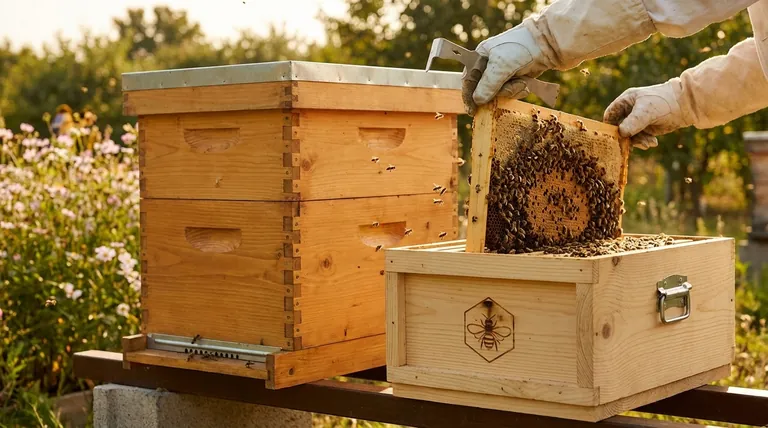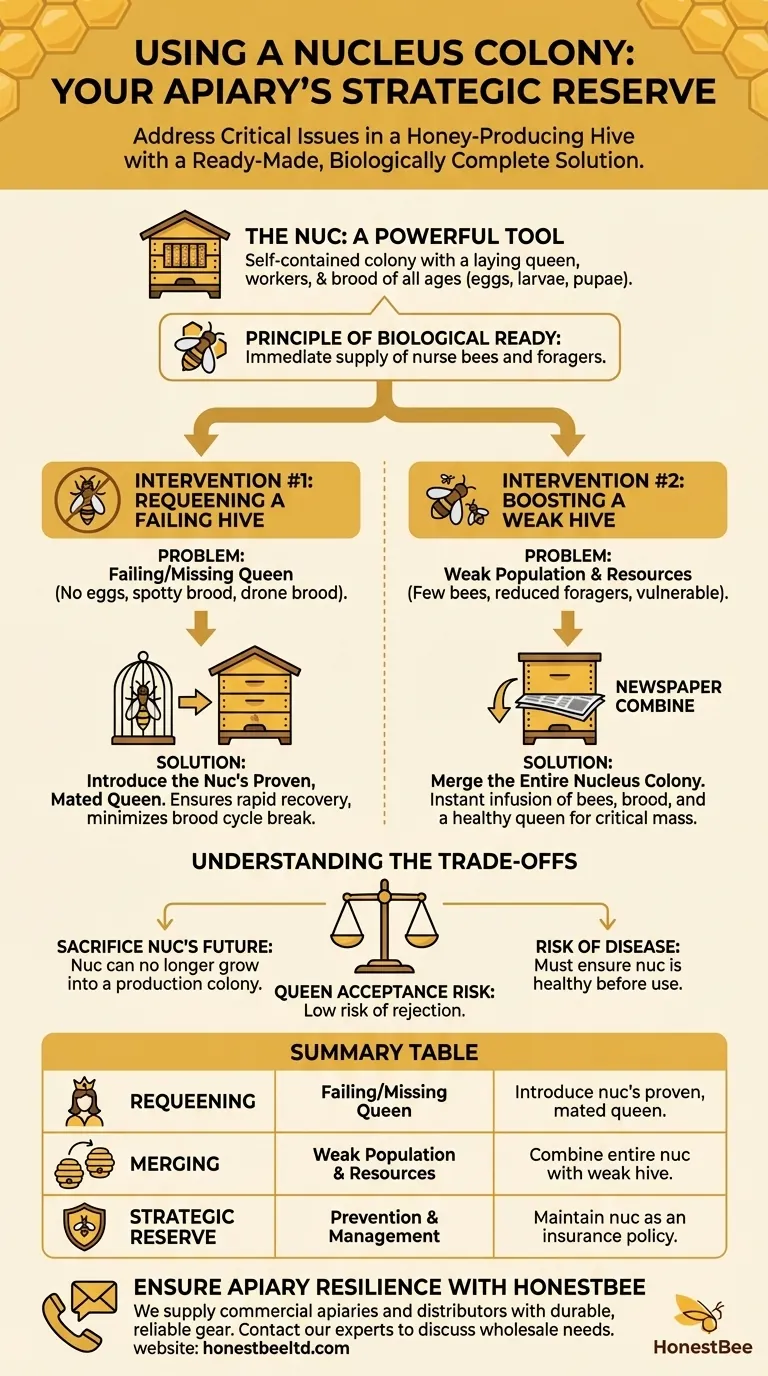A nucleus colony is a powerful tool for resolving critical issues within a honey-producing hive. You can either use the nuc's queen to replace a failing or missing one, or merge the entire nucleus colony to rapidly bolster a weak hive's population and resources. This provides a swift, biologically complete solution to get your main hive back to productive strength.
A nucleus colony is more than just a starter hive; it is your apiary's strategic reserve. By maintaining a nuc, you gain the flexibility to solve the two most common hive failures—queen loss and dwindling population—with a ready-made, biologically compatible solution.

The Nuc as a Strategic Apiary Resource
To effectively use a nucleus colony (nuc), you must first understand its fundamental advantage. It is not just a collection of bees; it is a fully functioning, miniature ecosystem.
What is a Nucleus Colony?
A nucleus colony is a small, self-contained honey bee colony. It typically consists of three to five frames containing a laying queen, worker bees, and brood of all ages—eggs, larvae, and capped pupae.
The Principle of Biological Readiness
A nuc's power lies in its completeness. Unlike a package of bees, which must wait 21 days for the first new workers to emerge, a nuc has a continuous cycle of bees already in motion.
This "biological readiness" means it has an immediate supply of nurse bees to care for young, and emerging foragers ready to gather resources.
Intervention #1: Requeening a Failing Hive
One of the most common and urgent problems a beekeeper faces is a failing queen. A nuc provides the fastest and most reliable solution.
Diagnosing the Problem
Signs of a missing or underperforming queen include a complete lack of eggs, a spotty brood pattern, or the presence of only drone (male) brood. The hive's population will soon decline without intervention.
The Solution: Introducing the Nuc Queen
You can carefully find and remove the failing queen from your production hive. Then, you can introduce the queen from your nucleus colony, typically inside a queen cage to ensure the hive accepts her scent before release.
Why This Works
This method is far quicker and more reliable than hoping the hive can raise its own emergency queen. You ensure the hive receives a young, mated, and proven laying queen, minimizing the break in the brood cycle and accelerating the hive's recovery.
Intervention #2: Boosting a Weak Hive
Sometimes a hive is queen-right but its population is too small to thrive, often after a harsh winter, disease, or pesticide exposure.
Diagnosing the Problem
A weak hive will have few bees, struggle to cover all its frames, and have a reduced number of foragers. It cannot effectively defend itself or gather enough nectar to grow.
The Solution: Merging the Nucleus Colony
The entire nucleus colony—bees, brood, queen, and frames—can be used to strengthen the weak hive. This is often done using a "newspaper combine," placing a sheet of newspaper between the two colonies to allow他们的 scents to mingle slowly and prevent fighting.
Why This Works: An Instant Infusion of Resources
Merging a nuc provides an immediate and massive boost. You are not just adding bees; you are adding a workforce of nurse bees, a large amount of brood that will soon emerge, and a healthy queen. This infusion breaks the cycle of decline and gives the hive the critical mass needed to recover and become productive.
Understanding the Trade-offs
Using a nuc as a support tool is a strategic decision that comes with clear trade-offs. It is not a "free" resource.
You Sacrifice the Nuc's Future
The most obvious trade-off is that when you use a nuc to boost or requeen another hive, you consume that nuc. It can no longer grow into its own full-sized production colony.
Risk of Disease Transmission
It is absolutely critical to ensure your nucleus colony is healthy before using it to aid another hive. If the nuc has any disease or pests, such as Varroa mites or foulbrood, you will introduce that problem directly into your larger colony.
Queen Acceptance is Not Guaranteed
When introducing a new queen, even with proper technique, there is always a small risk the hive will reject and kill her. This risk is low but must be considered.
Making the Right Choice for Your Hive
Your decision to use a nuc should be based on a clear diagnosis of your production hive's problem.
- If your primary focus is replacing a missing or failing queen: Use the queen from your nucleus colony for a rapid and reliable requeening.
- If your primary focus is to save a weak but queen-right hive from collapse: Merge the entire nucleus colony to provide an immediate boost in population and brood.
- If your primary focus is long-term apiary health and resilience: Maintain one or more nucleus colonies throughout the season as a strategic insurance policy against future problems.
Viewing your nucleus colony as a strategic asset transforms it from a simple starter hive into your most valuable tool for apiary management.
Summary Table:
| Intervention | Problem Solved | Key Action |
|---|---|---|
| Requeening | Failing/Missing Queen | Introduce the nuc's proven, mated queen. |
| Merging | Weak Population & Resources | Combine the entire nuc with the weak hive. |
| Strategic Reserve | Prevention & Management | Maintain a nuc as an insurance policy for your apiary. |
Ensure your apiary's resilience with the right equipment. A nucleus colony is a powerful tool, but its success depends on quality beekeeping supplies. HONESTBEE supplies commercial apiaries and beekeeping equipment distributors with the durable, reliable gear needed to manage nucs and production hives effectively. Let's strengthen your operation together—contact our experts today to discuss your wholesale needs.
Visual Guide

Related Products
- HONESTBEE Advanced Ergonomic Stainless Steel Hive Tool for Beekeeping
- HONESTBEE Professional Multi-Functional Hive Tool with Ergonomic Wood Handle
- HONESTBEE Professional Long Handled Hive Tool with Precision Cutting Blade
- Professional Dual-End Stainless Steel Hive Tool for Beekeeping
- Multi-Function Plier-Style Frame Grip Hive Tool
People Also Ask
- What is the hole in a hive tool for? A Multi-Tool for Apiary Repairs and Maintenance
- What are the basic tools for beekeeping? Essential Starter Kit for Safe & Successful Hive Management
- Why is it important to compare the progress of different hives? A Beekeeper's Key Diagnostic Tool
- What are the features of a regular hive tool? The Essential Multi-Tool for Every Beekeeper
- Why do hive tools have a hole? Unlock the Secret to Efficient Beekeeping



















